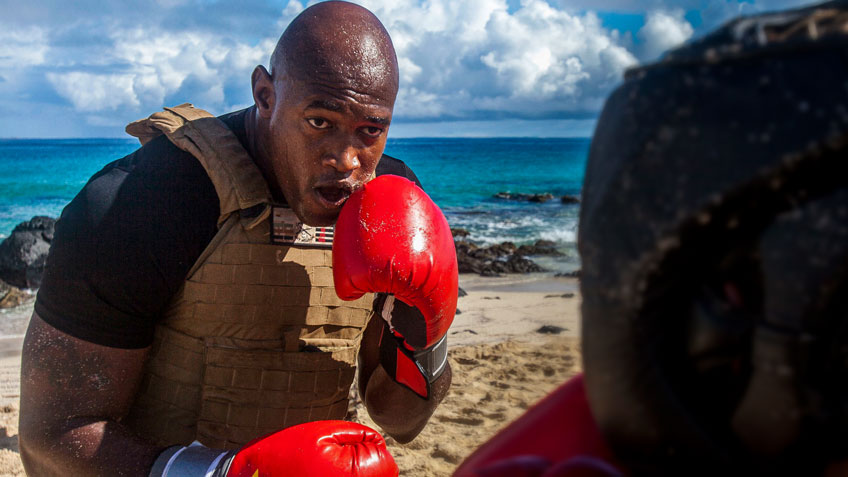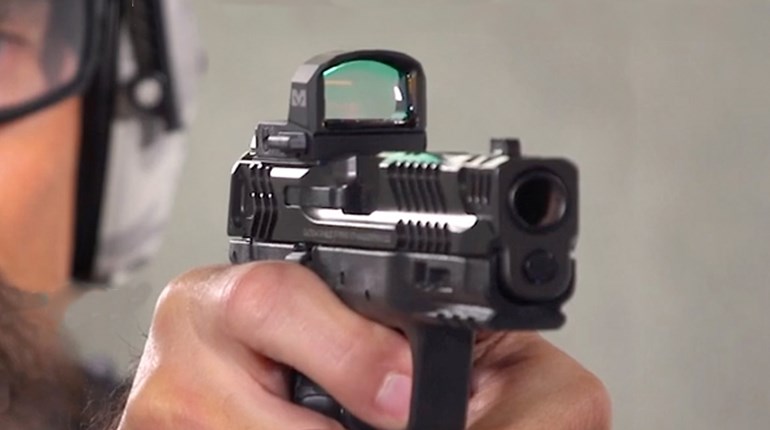
Military personnel are put through demanding physical training to help build mental toughness and combat skills, since both are vital for success and survival.
Foundations are set to align with desired results. If you want to prepare yourself for an optimal self-defense outcome against a real-world physical threat, then there are three self-defense cornerstones you can adopt to tip the scales in your favor. These are: mental toughness, a necessary state of mental readiness; threat recognition, the ability to identify and address a developing physical threat; and tactical performance, which is the capability to physically respond to an active threat on demand.
Mental Toughness
Paramount to any successful self-defense outcome is having mental toughness. It is not something you can learn online, at a weekend workshop or a self-defense seminar. It can only be developed from within. Referencing mental toughness, a quote often erroneously attributed to Thomas Jefferson puts it best: “Nothing can stop the man with the right mental attitude from achieving their goal, nothing on earth can help the man with the wrong mental attitude.”
What exactly is mental toughness? If you ask elite military personnel, mental toughness is the ability to remain calm in extremely dangerous or life-threatening situations and make the appropriate decisions to ensure mission success. If you ask an elite athlete, mental toughness is the ability to remain focused and perform well under stressful circumstances. If you ask the life-and-death incident survivors who escaped the impossible, many of them will tell you that mental toughness provided the willpower to get them through almost unimaginable hardships.
Mental toughness is the measure of individual resilience and confidence that can project success at home, at work, in competition and under duress. It refers to any set of positive, non-physical attributes that help you to cope with a threatening situation and perform under duress.
If you want what it takes to protect yourself and those around you, then you need this same mental toughness. How can you develop this critical self-defense component? It’s simply a matter of personal choice. Mental toughness is comprised of three very personal and interactive components: motivation, perseverance and resilience.
The first of these, motivation, is something that is derived from deep within. Exactly how motivated are you to defend yourself or those close to you? Having the willingness to make combat-effective round placement on one or more assailants is one thing, but are you willing to accept extreme hand-to-hand physical violence as part of your defensive solution in terms of a knock-down, drag-out, face in the dirt, bloody street fight? Could you drive a steak knife or a pair of scissors deep into the eye socket of someone attacking you? If you can put a checkmark next to these boxes, then you may very well have the motivation needed.
The second mandatory component of mental toughness is having the will or perseverance to succeed. Do you have the mental fortitude to push the fight forward, no matter what? When you use your will to face any challenge, regardless of how big or how small, just like building muscle in a gym, it strengthens your resolve. Perseverance translates to having an unshakable will to get through obstacles, no matter the circumstances.
Perseverance is the continued effort to do or achieve something despite difficulties, failure or opposition. If you have previously faced adversity and succeeded, then odds are in your favor that you may very well have the perseverance needed for self-defense.
The third and equally important component of mental toughness is mental strength or resilience. Resilience is the mental capacity to recover quickly from difficulties. It is the temper of mental toughness. Bouncing back when things get ugly gives you confidence which, in turn, makes you stronger.
Get comfortable being uncomfortable. You can’t get stronger if you never leave your comfort zone. Learning to be comfortable in uncomfortable situations helps you to learn from the situation instead of escaping from it. Building up your resilience occurs each time you step outside your comfort zone.
Finding your motivation, being aware of your perseverance and acknowledging your resilience are what allow you to further cultivate your mental toughness. Cultivating mental toughness provides you a tremendous advantage. By developing the ability to stick it out, you set yourself up for success.
Mental toughness affords you the freedom to get through anything without fear of failure. It is an enduring quality that keeps you strong, confident and focused, even in the face of danger or adversity.
Threat Recognition
The second cornerstone of ensuring a successful self-defense outcome is threat recognition. We live in a world that demands you either control the threat or the threat controls you. The resource to meet that demand is knowing you can take and keep control of your environment by being made aware of a potential or developing threat and knowing how to address it.

You can develop the skills and confidence needed to recognize an emerging or evolving threat, even at the slightest presentation of indicators. If there is such a threat, then you can be trained not only to identify it, but also to handle it appropriately. Threat recognition is the element of self-defense that allows you to detect the earliest-possible warning signs of a developing threat.
How many times have you looked directly at your watch to find what time it was, but failed to see it and needed to look again? You were looking right at it, but failed to see it. Why? Your eyes were physically looking, but you weren’t there. Your mind was elsewhere. So how do you actually see what you’re looking at? Apply good situational awareness.
Good situational awareness is the ability to observe, identify, process and comprehend the critical elements of information about your immediate environment. In other words, it’s knowing what’s going on around you because you’re mentally involved in the process. It’s when you look and see. Most people believe situational awareness is simply looking around at your environment, but the truth is that looking around and not seeing is the same as not looking at all.
Humans are equipped with organic tools that help us read our environment. Some of these tools we are born with, and some may be further developed via training. These tools include your five senses: sight, sound, touch, taste and smell, as well as hunches—an intuitive hint or gut feeling. How can you use and develop them into valuable observation skills?
One way is effective use of your five senses. Your eyes can readily observe the people and events around you. They can read nonverbal signs and scenarios unfolding, like people in a heated conversation or aggressive physical movement. Your ears can recognize the sound of screeching car tires, gunfire or people screaming. Your nose can identify a gas leak or smoke from a fire. Your skin can detect a change in temperature, like when you are standing next to a fire. Your tongue can detect ash, pepper spray and the like.
Your senses can be used as finely tuned environmental sensors to identify, collect and deliver multiple data points to your awareness for processing. Such indicators “tell” you what’s going on with a suspicious person or scenario you may be watching.
Another such tool is the “sixth sense” or a gut feeling. It’s when you “just know” that something isn’t quite right. It happens to be the most fine-tuned of the early-warning tools you have, and it shouldn’t be ignored.
In his book, “Blink,” which is about the intuitive parts of decision-making, Malcolm Gladwell presents a concept he calls “thin-slicing.” He posits that there can be “as much value in the blink of an eye than in months of rational analysis.”
Gladwell encourages his readers to not push aside their first thought in favor of getting more information to make a decision. Some people are more intuitive, which doesn’t necessarily go hand-in-hand with intelligence or access to more information. Finding a blip anywhere on your radar screen is all the alert you need to know that something is up.
Protection experts often use situational awareness as a deterrent. When an aspiring predator knows you are on to him, he is far less motivated to continue with his antics.
The key component of threat recognition is your personal involvement as it keeps you attuned and prepared. Your mental acuity is raised or lowered based on the conditions of your environment.
Tactical Performance
The final, but equally important, cornerstone of ensuring a successful self-defense outcome is your tactical performance. Trying to build the physical skills needed to defend yourself by watching an online video just isn’t going to cut the mustard.
As a defensive-tactics and protective-services subject-matter expert, I am often asked at my professional training courses, “What is the best self-defense out there?” My response is “The one you practice.”
Yes, it certainly is important to read and watch videos to gain a conceptual understanding. However, translating that understanding to physical skill is an entirely different matter.
A three-tiered approach to achieving any objective is understanding, skills development and performance—in that order. You cannot gain the skill of something you don’t understand, and you cannot achieve consistent performance if you never develop the requisite skill.

Very few people can commit to the amount of time and effort needed to gain consistency in performance. What separates elite special operations personnel from the rest of the herd? Training, and a lot of it.
Hypothetically speaking, at one time I may have been hired to deliver professional training to a certain unnamed unit. Every Friday afternoon, if not deployed, its members were qualifying on the range. Failing the qual resulted in instant dismissal from the unit. Imagine having such a high-pressure requirement where your tactical performance is tested at the end of every week and if you were having an off day, you lost your job.
Most of us are not under that kind of pressure, but it clearly illustrates the necessity of ongoing training. Performance is built on a solid foundation of fundamental skills. Without those skills there can be no performance, and all skills are perishable.
The bottom line is that if you plan to go hands-on with one or more assailants, you need to build those requisite skills and put your time in the ring, rolling on the mat or in a dojo. If you plan to use an edged or impact weapon in self-defense, then find yourself a non-ballistic weapons training academy and build those requisite skills toward consistent performance. If your primary defensive tool is your handgun, you should seek out the best, reputable training available. Just as importantly, you should conduct dry practice at home to further develop your gun-handling skills and, most of all, get to a range to continue developing your marksmanship skills.
I know. We all have very busy lives and there’s only so much time in the day. Therefore, you need to adopt those skills that best suit your personal profile and put in the practice it takes to further develop them. You must commit to the amount of time it takes to convey those skills into tactical performance.
At the end of the day you are only as prepared to defend against a violent physical threat as you have prepared to defend against a violent physical threat. Your decision to make the time and commitment to do so affords you solid footing on the cornerstones of mental toughness, threat recognition and tactical performance—the bedrock of an optimal self-defense outcome.



































